- Kyren Williams has been the most dependable fantasy back: Williams is the only running back to average 17.0 fantasy points per game each of the last two seasons among those who played at least 28 of the 34 possible games.
- The Los Angeles Rams drafted Jarquez Hunter: Sean McVay has avoided an early back committee throughout his head coaching career, but Hunter and Blake Corum could either change that or completely take over.
- Subscribe to PFF+: Get access to player grades, PFF Premium Stats, fantasy football rankings, all of the PFF fantasy draft research tools and more!
Estimated Reading Time: 5 minutes

PFF’s Fantasy Football Player Profile series delivers the most in-depth fantasy football analysis available for the 2025 season.
Using PFF’s exclusive data, we evaluate player performance, competition for touches and how teammates and coaching staffs will impact each player's fantasy football outlook.
Last updated: 7:15 a.m. Wednesday, May 14
Player performance
Williams was a fifth-round pick in 2022. He was reportedly going to have a significant role in Week 1 of his rookie year, but an injury on his first special-teams play cost him the first half of the season. He returned in Week 10 and played over 50% of the team's offensive snaps in Weeks 11 and 12, but inefficient play left him as a backup to Cam Akers over the rest of the season. In 2023, Akers started Week 1, but Williams was the clear leader in the backfield. Akers was a healthy inactive in Week 2 and traded before Week 3, and Williams has been the starter for Los Angeles ever since.
He’s been the most effective runner from a fantasy perspective over the last two seasons combined. He ranks first in fantasy points per game from rushing at 14. He also ranks in the top five on a per-game basis in rushing yards (87.3), yards after contact (57.9), rushing touchdowns (0.93), rushing avoided tackles (3.8) and PPR fantasy points (18.8).
His fantasy value has come from a combination of volume and great play in 2023, followed by a decline in 2024. He ran the ball more often in 2024 but gained fewer yards per carry due to fewer long runs and more avoided tackles. He fumbled five times compared to twice in 2023, which had a notable impact on his PFF rushing grade and EPA. He also ran a lot of routes for a running back in 2023, but too many drops led to a very low target rate in 2024.
Volume is king in fantasy football, but his drop in efficiency was still noticeable to his fantasy value. He finished second in fantasy points per game in 2023 and 10th in 2024.
Williams is in the last season of his contract. While there are no current indications that the Rams are thinking of trading Williams, it’s worth noting that Williams has played notably better on zone run plays than man, yet the Rams run more man than zone. If Williams were to get traded, this would likely cut into his playing time, but he could also be on a team where he would be more efficient as a runner.
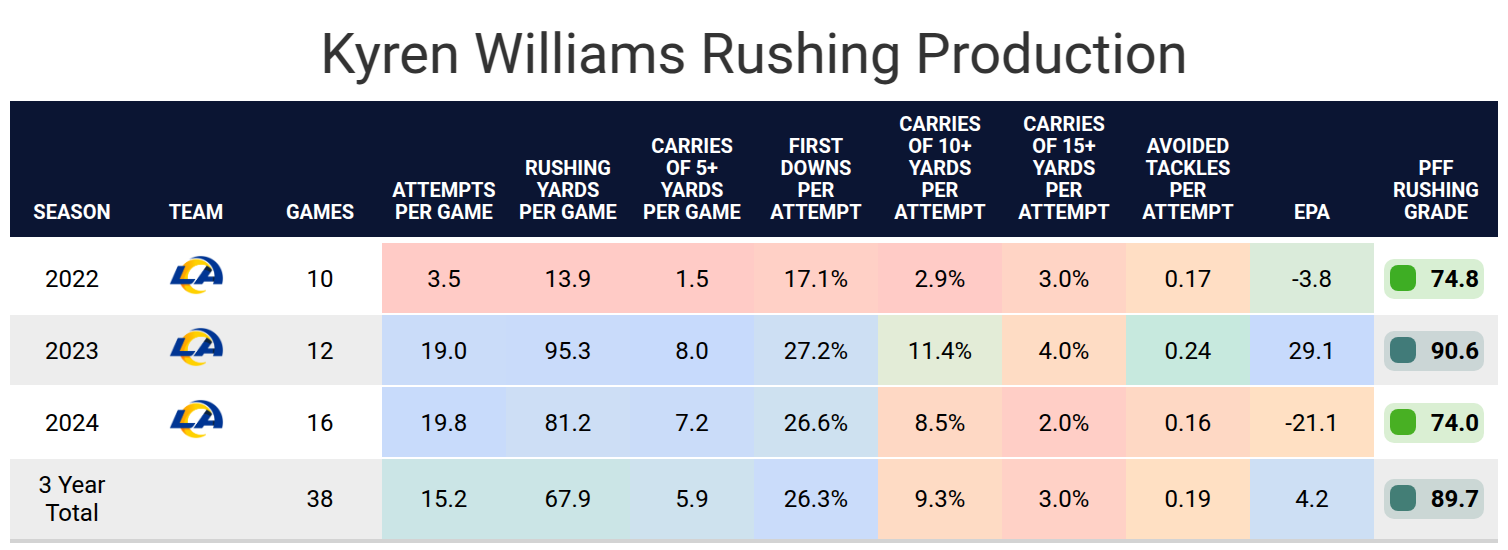
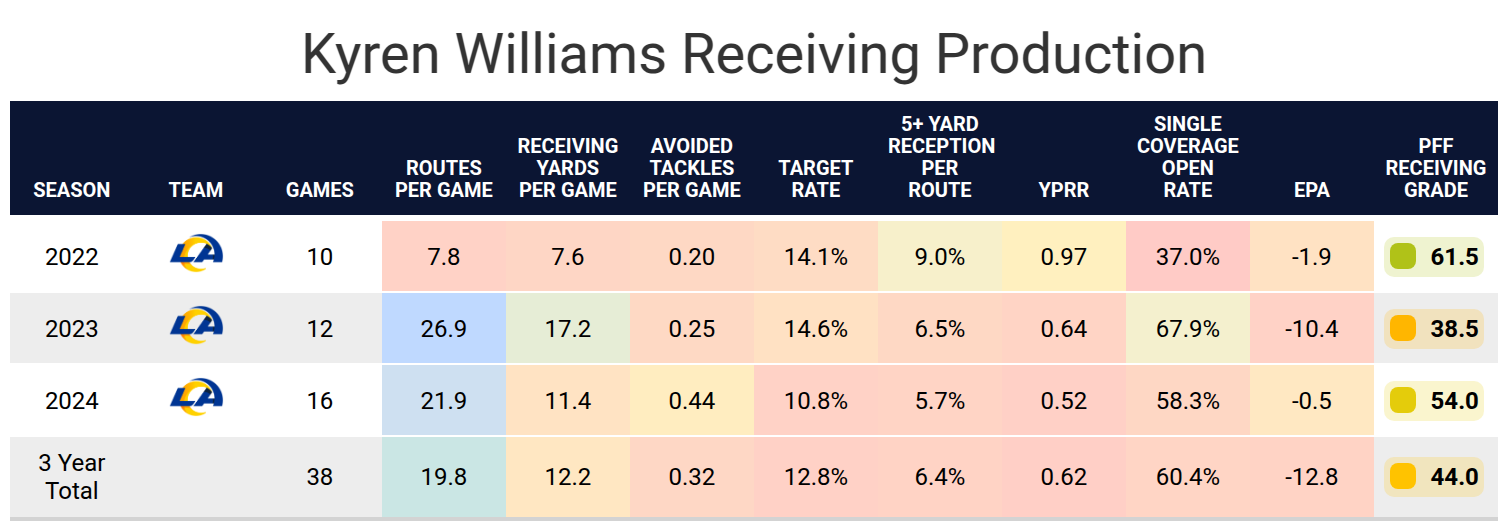
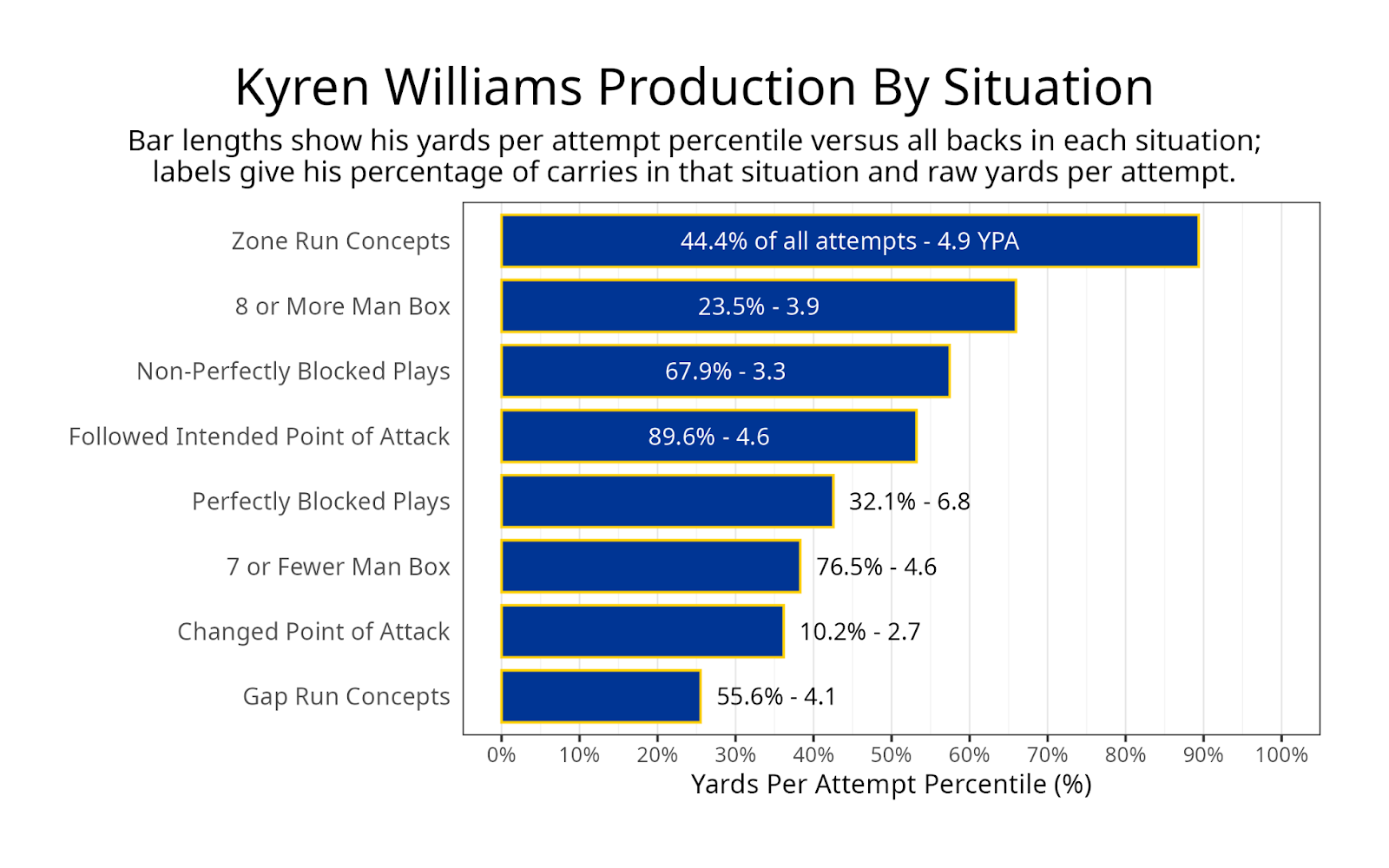
Projected role
Williams was used in a feature role in 2023, and despite the Rams drafting third-round rookie Blake Corum in 2024, he played even more snaps. Corum generally received either the second or third drive of the game and barely any playing time before or after that point. The Rams drafted Jarquez Hunter in the fourth round of the draft, giving the backfield even more depth. On one hand, that could be a bad sign for how the team views Corum, but on the other, the Rams have drafted a running back in each of the last eight drafts.
We should expect Williams to play fewer snaps in 2025. His increased playing time potentially impacted his efficiency. This loss of snaps could occur on third downs, as he’s been relatively inefficient in those situations. This is an area where Hunter is somewhat experienced, and Corum was relatively effective on a limited sample size. Sean McVay’s Rams have used a third-down back in the past, most notably Malcolm Brown. This could be ideal for Williams, as his fantasy value on third downs has been minimal, and that would leave him more well-rested for when he is receiving the ball.

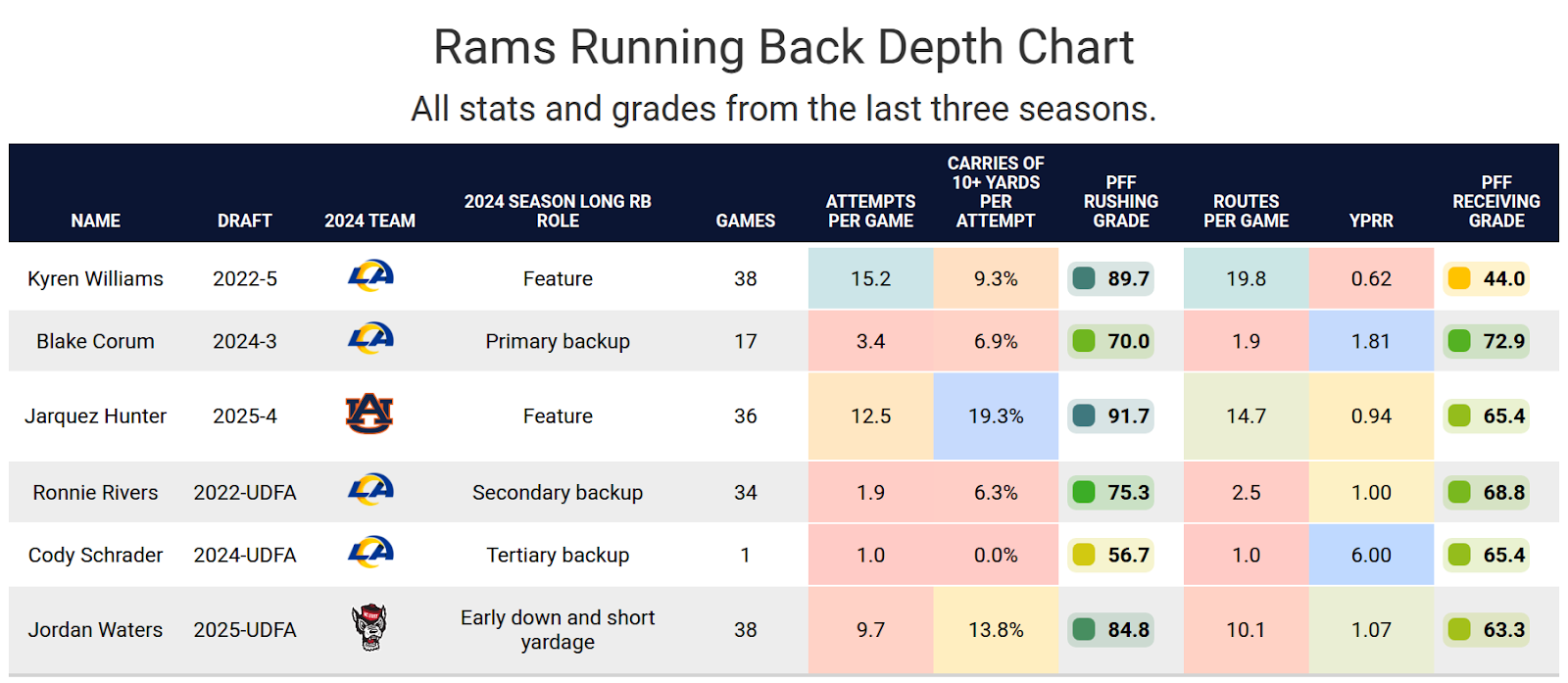
Impact of teammates
Williams will continue playing with Sean McVay as his head coach. McVay has always had a primary runner who receives at least 14 carries per start. He’s continued that regardless of whether it’s Todd Gurley, Cam Akers, Darrell Henderson, Sony Michel or Kyren Williams starting. In 2020, Akers averaged 6.0 carries per game from Weeks 5-12 then suddenly became the primary back in Week 13, averaging 22.0 carries per game over the rest of the season. Similarly, the Rams were happy to give Michel 20.2 carries per game when he was the starter, but only 5.5 carries per game as a backup.
Since McVay became head coach, the Rams have ranked fourth in rushing attempts differential between the starter and the backups. The other four teams are the Tennessee Titans, Dallas Cowboys, Las Vegas Raiders and Cincinnati Bengals. For most of that time, those teams had Derrick Henry, Ezekiel Elliott, Josh Jacobs and Joe Mixon, who are the four running backs with 1,600 or more carries. None of the Rams' running backs have over 1,000 carries in that time, making this a coach's philosophy more so than a particular running back's philosophy. Because of the Rams either switching up running backs in season or overworking one running back too much, their top running back by ADP has underperformed by end-of-year rank in five of the last six seasons. The one exception was 2021, when Henderson’s consensus ADP was RB26, and he finished as RB22 in points per game.
Based on McVay’s history, Williams should be the lead running back, while the two younger backs don't receive many carries per game. However, if one of them can overtake Williams as the primary running back, then Williams' fantasy value will completely disappear. Based on his history of changing running backs when Akers, Henderson and Michel were on the team, the recent investment in mid-round running backs, Williams being in the last year of his contract, and Williams’ declined play in 2024, this is a clear possibility.
The Rams have put together an ascending offensive line. The right side has performed well for multiple seasons, while the left side, featuring Alaric Jackson and Steve Avila, improved significantly last season compared to the previous year. Their biggest weakness was at center, where they brought back Coleman Shelton after he played one season with the Chicago Bears. In his last season with Los Angeles in 2023, he received a 74.6 run-blocking grade. If everyone can play at the same level they did in their most recent season with Los Angeles, we could see a top-five run blocking performance. However, it is worth noting that right tackle Rob Havenstein will be 33 years old before the season and had offseason shoulder surgery. His run-blocking grade was slightly lower than usual last season at 79.6, and a decline in his quality of play would be completely understandable.

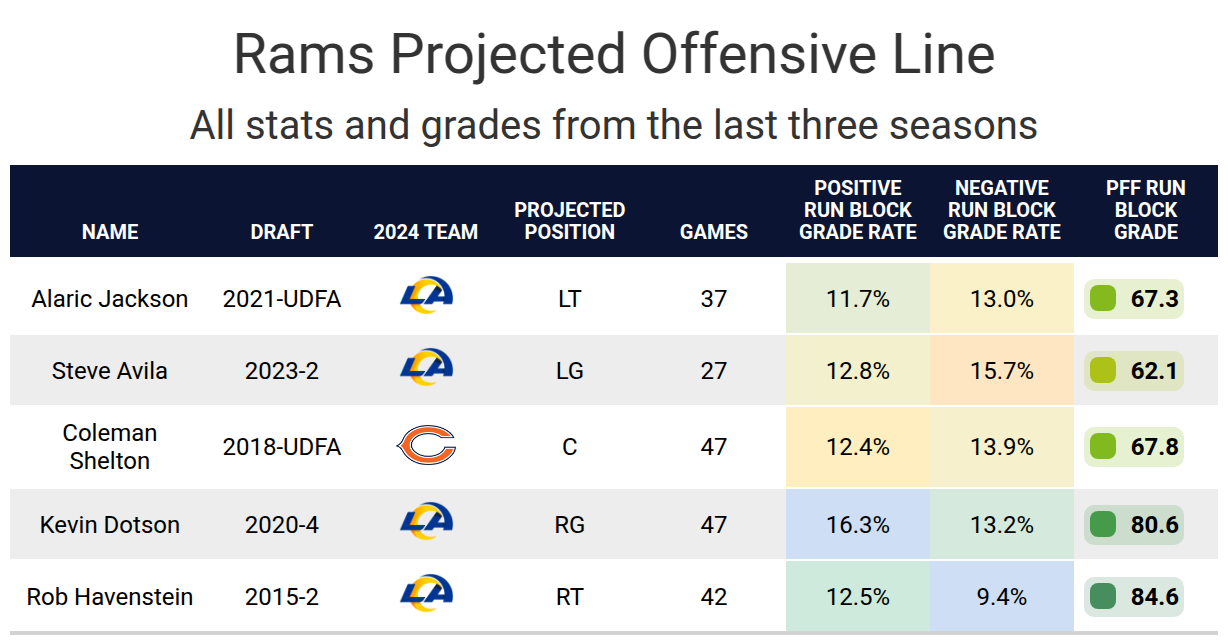
Bottom line
Williams had a high floor last season thanks to his volume, but his weeks as a top-12 running back fell due to increased per-play production. Sean McVay sticks with one running back, so if Williams is the starter, he will remain a top-15 fantasy running back. However, there is no guarantee Williams will remain the starter.

Footnotes
- Statistics in tables and charts were chosen based on their ability to predict future fantasy performance on a per-game or per-opportunity basis or to describe the player relative to others at the same position.
- “Opportunities” are defined as passing dropbacks, rushing attempts and routes run as a receiver.
- Numbers are provided either by season or based on the past three years. For rookies, only college statistics are included. For non-rookies, only NFL statistics are considered, regardless of whether they played in college within the previous three years.
- As college competition is easier than NFL competition, most rookies are likely to see a decline from their historical numbers.
- Only FBS data is considered for college players and comparisons.
- Kneel-downs are removed from rushing data to provide cleaner quarterback rushing rate statistics.
- The table colors in this article range from blue (indicating good/high) to red (indicating bad/low).
- All percentiles and color codings compare the given player to others with a high sample of opportunities. Generally, the cutoff is one-third of the possible opportunities in the sample. If a player does not meet the threshold, they are still included in the comparison, though their results may appear better or worse than expected due to the smaller, less predictive sample size.
- Information on utilization classifications and their importance can be found here for running backs, wide receivers and tight ends.



 © 2025 PFF - all rights reserved.
© 2025 PFF - all rights reserved.